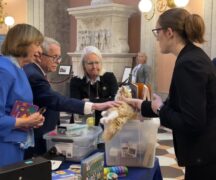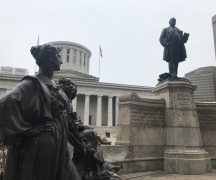BY SUSAN TEBBEN
Storytime came to the Ohio Statehouse as local librarians spelled out the ways budget cuts to the Public Library Fund could hurt the communities in which they work.
This week, current and past staff of libraries across the state laid out for lawmakers the different ways in which the libraries have played a role in their lives and the lives of their community.Constance Evans taught high school for 25 years, using libraries in the several counties in which she taught to supplement her English lessons and other topics.
After more than two decades, she went back to school to get a degree in Library Science. “More than anything, that year taught me how libraries had morphed into an eclectic mix of technology, print, and online materials, and valuable partnerships connected to every facet of our Ohio communities,” Evans told the Ohio Senate Education Committee.
One thing most library representatives who spoke brought up as an important – and popular – part of their role in the community was the age-old early literacy program called storytime. “Our storytimes are so popular that it’s not uncommon that our parking lot is full and people have to park elsewhere in the city to get to our library,” said Chauncey Montgomery, director of the Community Library in Sunbury.
For the Columbus Metropolitan Library, storytime is a stealthy way to slide learning in alongside entertainment and engagement. “What seems like a fun-filled 30-minute reading, singing and dancing session to the untrained eye is a well-planned kindergarten readiness program designed around the four cornerstones of reading — letter recognition, beginning letter sounds, rhymes and vocabulary,” said Lauren Hagan, CEO of the Columbus library system.
Storytimes are fairly universal among libraries in the state, but there are other programs that are more tailored to the particular area of the state the library calls home. New Carlisle is an area with a poverty rate of 20.5%, compared to the 13.3% that stands as the state average. Food insecurity is a significant issue for families who come to the New Carlisle Public Library, according to director Beth Freeman. “We have begun offering a dinner storytime, where all family members are able to have a good meal provided by a local restaurant and hear an entertaining story one evening a month,” Freeman told the committee.
Programs of all kinds could be on the chopping block if funding changes are implemented, in a day and age when libraries have already had to be creative with existing funds as library demand and demand for more modern resources goes up. The Public Library Fund, which is currently a percentage of the state’s General Revenue Fund, saw a $27 million loss last year.“ Public funds have given our library the ability to be innovative, creative and enduring,” said Aimee Fifarek, director and CEO of the Public Library of Youngstown and Mahoning County. “All these services and programs were all made possible because our elected leaders invested in our community.
The House’s version of the budget would eliminate the 1.7% the Public Library Fund gets from the General Revenue Fund, and create a line-item appropriation. Legislators argued that would be a better deal for libraries, because they would avoid the fluctuations of state tax revenue from year to year.
“I’m not wanting to cut funding for libraries,” said state Sen. Kyle Koehler, R-Springfield, a member of the Senate Education Committee. “But we have a hard time understanding how a percentage of a fluctuating GRF somehow makes it easier for you.”
Advocates fear going to a line-item appropriation rather than a percentage of state tax revenue could put them at risk for “across the board cuts” if the state needed to tighten its belt, as it did during the COVID-19 pandemic, according to Michelle Francis, head of the Ohio Library Council.
“We’ve seen lots of programs that are line-items get eliminated, and so I will tell you that that is a strong concern going forward,” Francis said.
The budget approved by the House also rejected a proposal from the governor’s executive budget that would have raised the PLF distribution to 1.75%. An increase of that size would amount to another $15 million each year for public library coffers, according to Jay Smith, director of government and legal services for the Ohio Library Council.
With the rise in visits to libraries, up 3.4 million to 48 million visits statewide in 2024, according to the council, advocates have taken to comparing the crowds who visit their facilities to audiences at football games. Francis has frequently used Ohio Stadium as a model, saying the statewide number of visits to libraries could fill the Shoe more than 400 times.
“I haven’t compared that (2024 increase) to the Browns stadium, but that’s our next goal,” she told the committee.Fifarek said 2024 numbers for Youngstown/Mahoning County libraries showed a population that would fill Youngstown State University’s Stambaugh Stadium more than 30 times.
Despite the consistent crowds, libraries only see funding through the Public Library Fund and local levies, with the exception of 48 library systems who don’t have levies on the books.
“We are responsible for our own buildings, but yet we do not receive money in the capital bill,” Francis said, referring to the state’s separate spending bill for infrastructure and other projects. “We also don’t get county sales tax, city income tax, no casino revenue, we didn’t get any direct (American Rescue Plan Act) funds, and we don’t have inside millage. So, that state funding is incredibly critical, and we rely on it more and even greater than our partners do the (local government fund).
”The Senate is currently working on its draft of the budget, which could contain changes to the House’s version. The two chambers will come together after the Senate approves a draft to bring forth a final draft for the governor’s signature before July 1.





